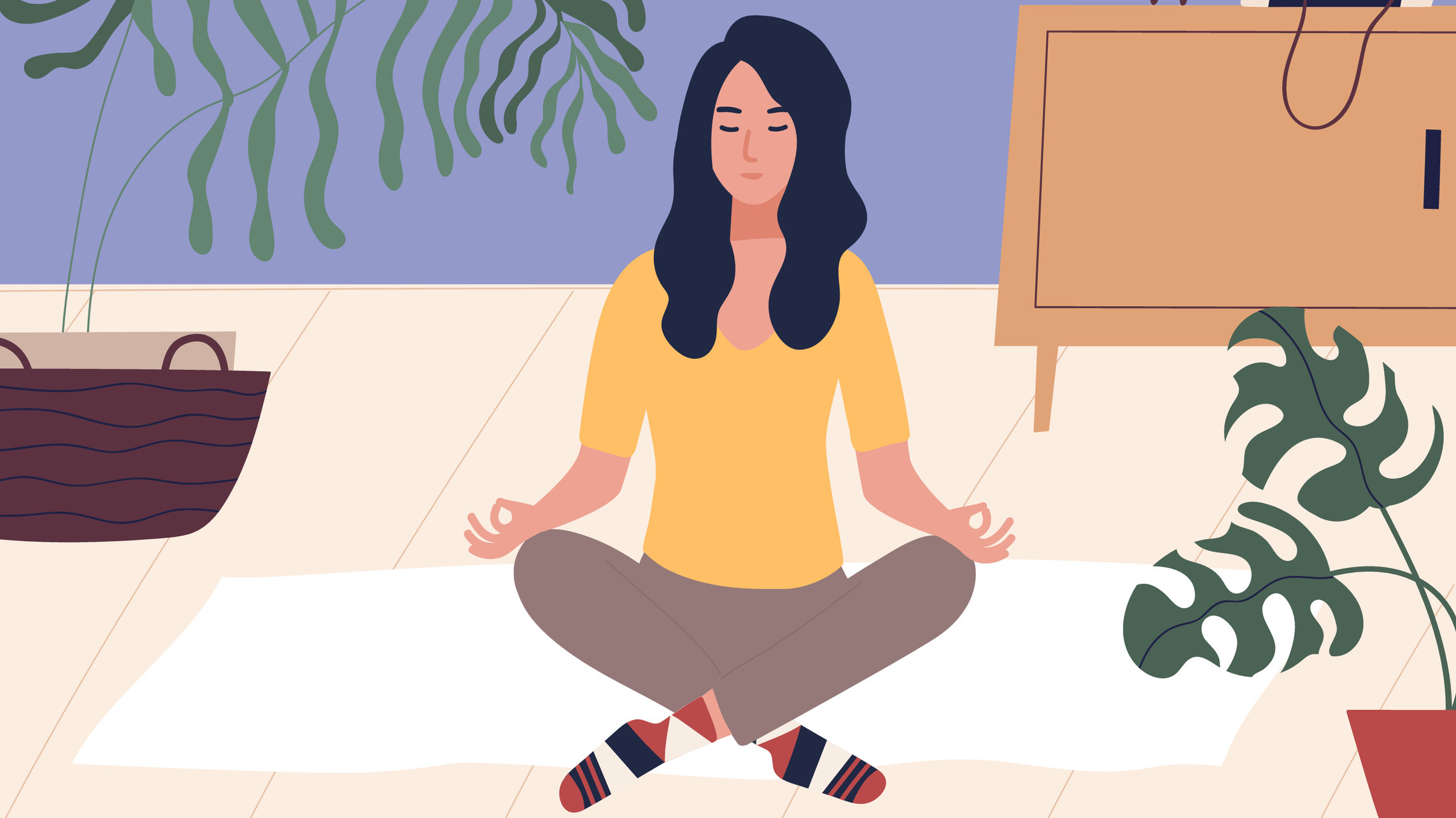
In Buddhism, walking as meditation is often called kinhin. It is a movement between periods of sitting meditation. The practice is common in Mahayana, Theravada and other traditions. Many benefits can be derived from walking meditation. Some practitioners prefer walking over sitting and a simple walk between two points can be very beneficial. This article will discuss the benefits of walking as meditation. It's worth looking into why Buddhists prefer walking to meditation.
Meditation can be practiced anywhere by walking. Simply find a quiet spot and stand at the end of a path. Begin to notice what your body is doing. Take note of the pressure on the bottom of your feet and other sensations as you walk. This process can be repeated as you walk. This will allow you to become more mindful and calm. This meditation can also be used to help you feel less overwhelmed. These links will provide additional information on walking meditation.

To practice walking as meditation, you must be still for a while. Pay attention to your breathing and body for a few more minutes. Continue doing this for ten to twenty minutes. Although you can walk longer distances, it's important to keep your pace in line with your body. You will find that your mind wanders less as you walk. This does not necessarily mean that your mind is wandering. It just means you need to take some time to calm down.
Walking as meditation requires that you take a moment to ponder your thoughts. Don't analyze the thoughts that come to you, just notice them. You may find it useful and beneficial to learn from your experiences. By doing this, you will be able to bring your awareness into everyday life. It is vital to pay attention to your surroundings. Following these steps can help you develop a daily practice for walking as meditation.
You should pay attention to your body when you are walking as meditation. Your body needs to be free from distractions and relax. Nature can provide that space. While being aware of your body and emotions, you can also be mindful. Your mind will drift away from your thoughts and you'll feel more peaceful, at peace, and calmer. You will be surprised by how much more relaxed you feel when you're walking as a meditation.

You should be aware of everything around you when you are walking meditation. Your leg movements and the ground should be monitored. During walking, you should be aware of all sensations in your body. You should also be aware of your thoughts while you're walking. This will help you to be more present. Walking is a great way to practice mindfulness. However, it cannot replace regular meditation.
FAQ
Here are 7 ways to live a healthy lifestyle.
-
Eat right
-
Exercise regularly
-
Sleep well
-
Drink lots of water
-
Get enough sleep
-
Be happy
-
Smile often
What are the 10 most delicious foods?
The 10 best foods to eat include:
-
Avocados
-
Berries
-
Broccoli
-
Cauliflower
-
Eggs
-
Fish
-
Grains
-
Nuts
-
Oats
-
Salmon
Supplements and herbs can improve immunity
Natural remedies and herbs can be used to increase immune function. There are many natural remedies that can boost immunity, including echinacea (oregano), ginger, ginkgo biloba and vitamin C.
These herbal remedies are not meant to replace medical treatment. They may cause side effects such as nausea, diarrhea, stomach cramps, headaches, dizziness, and allergic reactions.
Why is it important that we live a healthy and happy life?
Healthy lifestyles lead to happier and longer lives. A healthy diet, regular exercise and good sleep habits will prevent the development of diseases such as heart disease, stroke, cancer, diabetes, and Alzheimer's.
A healthy lifestyle will improve our mental well-being and help us deal better with everyday stressors. Healthy lifestyles will increase self confidence, and make us look and feel older.
What is the best food for me?
The best diet for you depends on several factors, like your age, gender, weight, health conditions, and lifestyle habits. Also, consider your energy expenditure, whether you prefer low-calorie food, and whether you enjoy eating fruits or vegetables.
Intermittent fasting is a good option if you're trying to lose weight. Intermittent fasting is a way to eat only certain meals during the day instead of three large meals. This might be better for you than traditional diets, which have daily calorie counts.
Intermittent fasting is believed to increase insulin sensitivity. It may also reduce inflammation. This may lead to a decrease in diabetes risk and blood sugar levels. Research also shows that intermittent fasting may increase fat loss and improve overall physique.
How can I reduce my blood pressure
Find out the causes of high blood pressure first. Then you need to take steps to reduce this cause. You can do this by eating less salt, losing weight, or taking medication.
Exercise is also important. You can also walk if you don’t have the time.
Consider joining a gym if your current exercise regimen is not satisfying you. It's likely that you will want to join a gym with other people who are working towards the same goals as you. You will find it easier to keep to a workout schedule if you have someone to watch you at the gym.
Statistics
- The Dietary Guidelines for Americans recommend keeping added sugar intake below 10% of your daily calorie intake, while the World Health Organization recommends slashing added sugars to 5% or less of your daily calories for optimal health (59Trusted (healthline.com)
- WHO recommends consuming less than 5% of total energy intake for additional health benefits. (who.int)
- WHO recommends reducing saturated fats to less than 10% of total energy intake; reducing trans-fats to less than 1% of total energy intake; and replacing both saturated fats and trans-fats to unsaturated fats. (who.int)
- According to the 2020 Dietary Guidelines for Americans, a balanced diet high in fruits and vegetables, lean protein, low-fat dairy and whole grains is needed for optimal energy. (mayoclinichealthsystem.org)
External Links
How To
What does the word "vitamin" mean?
Vitamins are organic compounds found naturally in food. Vitamins are necessary for us to absorb nutrients in the foods we consume. Vitamins cannot come from the body so food must provide them.
There are two types vitamins: water soluble or fat soluble. Water soluble vitamins dissolve easily in water. Some examples include vitamin C,B1 and B2 vitamins (thiamine), B2 and riboflavin, B3 and B6 vitamins (niacin), folic acids, biotin, pantothenic acids, and cholesterol. The liver and fat soluble vitamins are stored within the liver and in fatty tissue. Some examples include vitamin D and E, K, A and beta carotene.
Vitamins are classified according to their biological activity. There are eight major types of vitamins:
-
A - Essential for healthy growth and health maintenance.
-
C - important for proper nerve function and energy production.
-
D - Vital for healthy bones and teeth
-
E - Required for good vision & reproduction
-
K - Required for healthy nerves and muscles.
-
P - Vital for strong bones and teeth.
-
Q – aids digestion of iron and iron absorption
-
R - Required for red blood cell production
The recommended daily allowance of vitamins (RDA), varies according to age, gender, physical condition, and other factors. The U.S. Food and Drug Administration has established the RDA values.
For adults over 19 years, the RDA is 400 mg per day for vitamin A. Pregnant mothers need 600 micrograms per days because it is vital for the development and growth of their baby. Children ages 1-8 require 900 micrograms per day. Infants under one year of age require 700 micrograms per day, but this amount decreases to 500 micrograms per day between 9 months and 12 months of age.
Children between the ages 1--18 years old who are overweight or obese require 800 micrograms per Day, while those who are overweight or obese need 1000 micrograms. To meet their nutritional needs, children underweight and obese require 1200 micrograms a day.
Children between 4 and 8 years old with anemia will need 2200 micrograms daily of vitamin C.
2000 micrograms daily is required for adults over 50 to maintain their general health. Breastfeeding or pregnant women require 3000 micrograms per daily due to higher nutrient demands.
1500 micrograms is the recommended daily intake for adults aged 70+, who lose approximately 10% of muscle each year.
Women who are pregnant, nursing or breastfeeding need more than the RDA. Pregnant women need 4000 micrograms per dayduring pregnancy and 2500 micrograms per day after delivery. Breastfeeding mothers need 5000 mg per day when breastmilk is being produced.